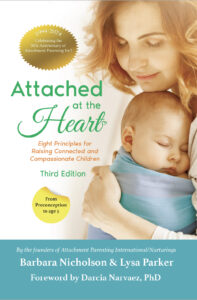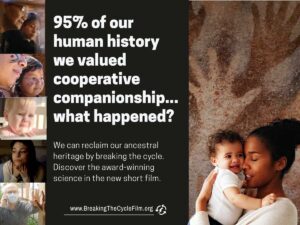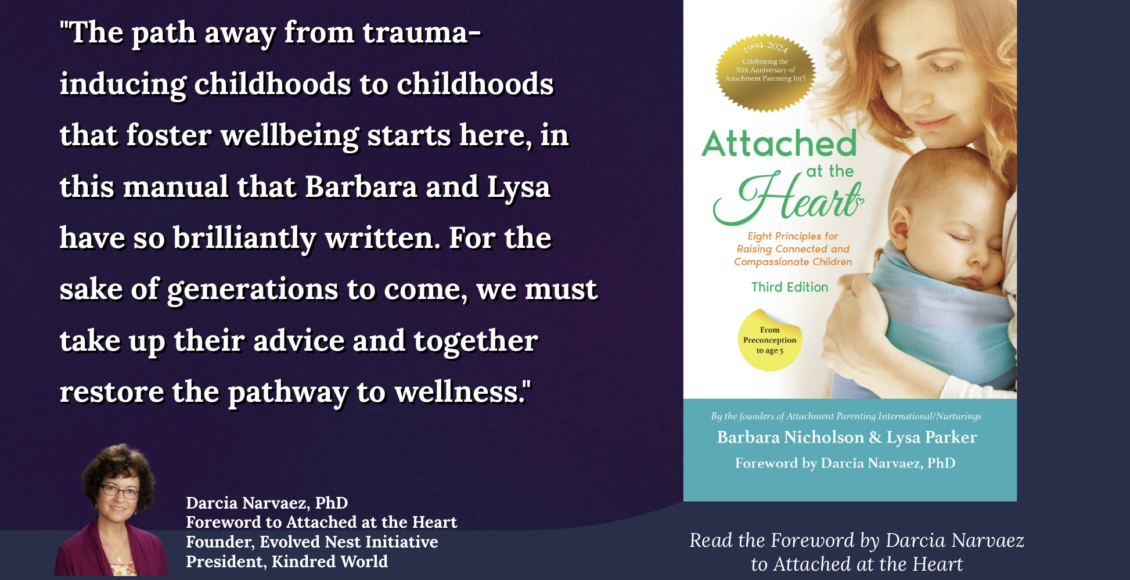Attached At The Heart: The Foreword by Darcia Narvaez
The Foreword by Darcia Narvaez to Attached at the Heart.
Attachment caregiving offers an approach that closely matches up with our species’ “evolved nest,” shaped over millions of years to meet built-in basic needs, optimizing development and wellbeing. The evolved nest is provisioned by the community and includes soothing perinatal experiences, extensive breastfeeding and positive touch, a welcoming social climate with responsive relationships and a stable set of caregivers, self-directed play, nature immersion, and routine healing practices. My lab’s research shows that those who experience more of the evolved nest in childhood are more likely to be mentally healthy, securely attached, socially skilled, and morally compassionate. Attachment caregiving is a central part of the evolved nest that fosters cooperation and contentment, healthy individuals, and families. Attachment caregiving and the evolved nest were universal for 99% of humanity’s existence but were degraded over millennia in hierarchical societies, a deterioration that has become more widespread and accelerated in recent decades.
 The dominant culture has been pushing parents away from the evolved nest and attachment caregiving, away from nurturing and being nurtured. As part of “don’t spoil the baby” and “kids are resilient” narratives, the dominating discourse has sought to minimize mothering in the lives of children. In fact, whether statements, claims, attitudes, or advice, such messages tend to spoil parents, not the baby, undermining parent confidence in their own deeper instincts to nurture and sacrifice for the baby’s wellbeing. Such anti-nurturing advice can mislead parents away from following the natural flow of providing for the basic needs of their child. Parents and parenting sensitivity are undermined by lack of social support for offering a loving, nurturing nest.
The dominant culture has been pushing parents away from the evolved nest and attachment caregiving, away from nurturing and being nurtured. As part of “don’t spoil the baby” and “kids are resilient” narratives, the dominating discourse has sought to minimize mothering in the lives of children. In fact, whether statements, claims, attitudes, or advice, such messages tend to spoil parents, not the baby, undermining parent confidence in their own deeper instincts to nurture and sacrifice for the baby’s wellbeing. Such anti-nurturing advice can mislead parents away from following the natural flow of providing for the basic needs of their child. Parents and parenting sensitivity are undermined by lack of social support for offering a loving, nurturing nest.
With undermined instincts, parents turn to parenting advisers who claim that modern experiments show that parents are not much needed by babies. Looking at one or two variables, typically over a short time period, with sloppy methodology and no understanding of the evolved nest and its effects, these studies get published and cited because they support the dominant paradigm: nurturing does not matter. The “parenting by experimental evidence” is the detached form favored by advisers divorced from the holistic wellbeing of the baby and mother, commonplace throughout the 20th century. Such advice focuses on parent control and promotes a nevermindedness – the mother has better things to do than relate to the baby. John Bowlby put it this way:
“Although the overriding need of an infant and child for love and security is now well-known, there are some who protest against it. ‘Why should an infant make such demands? Why can’t he be satisfied with less care and attention? How can we arrange things so that parents have an easier time?’ In the meanwhile, we should be wise to respect [the child’s] needs and to realize that to deny them is often to generate in [the child] powerful forces of libidinal [affectionate attachment] demand and propensity to hatred which can later cause great difficulties for both [the child] and us.” [italics added]

Indeed, society pays the price of under-nurtured, under-cared-for children. In the United States, where Ian Suttie noted there is a “taboo on tenderness,” we have burgeoning epidemics of mental and physical illness, suicide, and violence at all ages.
Parent-child separation occurs mentally at first, when the expectant mother is not encouraged to think of herself as a dyad with a fetal companion in need of tender experience. Discussions of maternal-child competition and power struggles already start at this stage. It continues with actual separations enforced by medical personnel at birth and lack of skilled, knowledgeable support for breastfeeding and skin-to-skin bonding. Individualistic treatment of mothers and their children, as if they are separate instead of entangled beings, contributes to the ongoing de-mothering. Mothers are expected to return to work shortly after giving birth and leave young children to be raised by others. In the United States, where there is minimal support for mothers and families, disconnection, and detachment from babies in this way is almost a relief. Instruments of separation that modern society expects to keep baby in, like strollers, playpens, plastic carriers—if used a great deal—continue to promote dis- connection. Disconnection of parent from child and child from parent.
Of course, parent detachment from the baby fosters in the child a similar emotionally detached orientation to relationships. The child is expected to learn to survive without relational and emotional connection, and so develops insecure attachment – avoidant, anxious, disorganized, or even reactive attachment disorder. The USA has become a nation of radically disconnected individuals today – from self, others, and the rest of the natural world. It’s easy to act in destructive ways when you feel emotionally and relationally disconnected. The individual has learned that they don’t really matter and no one else really does either. The individual can develop a ghostly, dissociated, volcanic, or oppositional personality, which may not emerge until adolescence, but undermines free will to be present and attuned to others. Adverse childhood experiences (ACEs) are commonplace today in the United States, emerging from the lack of psychobiological support in the family that cascades into drug addiction, abuse, and violence across generations.

Humanity evolved within a biology of love, according to biologist Humberto Maturana. That is, we each have a biology that is dependent on loving care to develop properly as healthy, social beings. Holistic support in childhood allows our full human capacities to emerge in a state of wellbeing. The most important thing in the world is to feel emotionally connected and attached, mutually present, and engaged with others through biological connection 24/7. Our long-term health and wellbeing depend on this early psychobiology of love.
Attachment caregiving provides a remedy. Positive early life experiences not only foster wellbeing but can also mitigate the effects of adversity. Attachment caregiving, rooted in the psychobiology of love, conveys to the child what has been communicated to the parents by the community: you matter. When a nurturing orientation in families is supported by the community, it seeds a cycle of cooperative companionship that results in a caring culture across generations (see our film at BreakingTheCycleFilm.org).
Barbara Nicholson and Lysa Parker beautifully describe principles and methods for providing a psychobiology of love for children. Covering a broad sweep of issues and providing many practical tips, Barbara and Lysa guide the reader in understanding and practicing attachment care- giving. The nurturing provided by attachment caregiving contributes to the healthy development of children’s bodies, minds, and psyches, main- taining psychosocial connectedness throughout the co-construction of a life together. In this new edition of the book, they take up and advise on biological features recently emerging in scientific circles, such as the micro- biome, breastsleeping, heart-brain coherence, and vagus nerve co-regulation. Attachment caregiving follows the deeper instincts of mothers and carers to maintain the wellbeing of the child through psychobiological attunement. Relational attunement is central, ensuring support for the rapidly developing right hemisphere, scheduled to grow more rapidly in early years. The right hemisphere governs all sorts of critical functions of self-control and relational intelligence, and it grounds self-esteem. With its proper development, the child is prepared for a life of conviviality – a skillful, relaxed, flexible know-how for getting along with others.
Attachment caregiving, as conveyed in these pages, supports parents and children on the wellness-promoting pathway our ancestors followed, one that brings about individual, family, and community wellbeing. The path away from trauma-inducing childhoods to childhoods that foster wellbeing starts here, in this manual that Barbara and Lysa have so brilliantly written. For the sake of generations to come, we must take up their advice and together restore the pathway to wellness.
Darcia Narvaez, PhD
Professor emerita of psychology, University of Notre Dame,
Founder, EvolvedNest.Org
Bibliography
Bowlby, J. (1979). The making and breaking of affectional bonds. Tavistock, p. 8.
Breaking the Cycle (https:www.breakingthecyclefilm.org)
Felitti, V. J., & Anda, R. F. (2005). The Adverse Childhood Experiences (ACE) Study. Centers for Disease Control and Kaiser Permanente.
Hrdy, S. (2009). Mothers and others: The evolutionary origins of mutual under- standing. Belknap Press.
Maturana, H.R., & Verden-Zoller, G. (2008). The origin of humanness in the biology of love. Imprint Academic.
Narvaez, D., & Bradshaw, G.A. (2023). The Evolved Nest: Nature’s way of raising children and creating connected communities. North Atlantic Books. Schore, A.N. (2019). The development of the unconscious mind. W.W. Norton. Suttie, I. (1935). The origins of love and hate. The Julian Press.
Tarsha, M. S., & Narvaez, D. (2022). Effects of adverse childhood experience on physiological regulation are moderated by evolved developmental niche history. Anxiety, Stress & Coping, 35(4):488-500. DOI: 10.1080/10615806.2021.1989419


